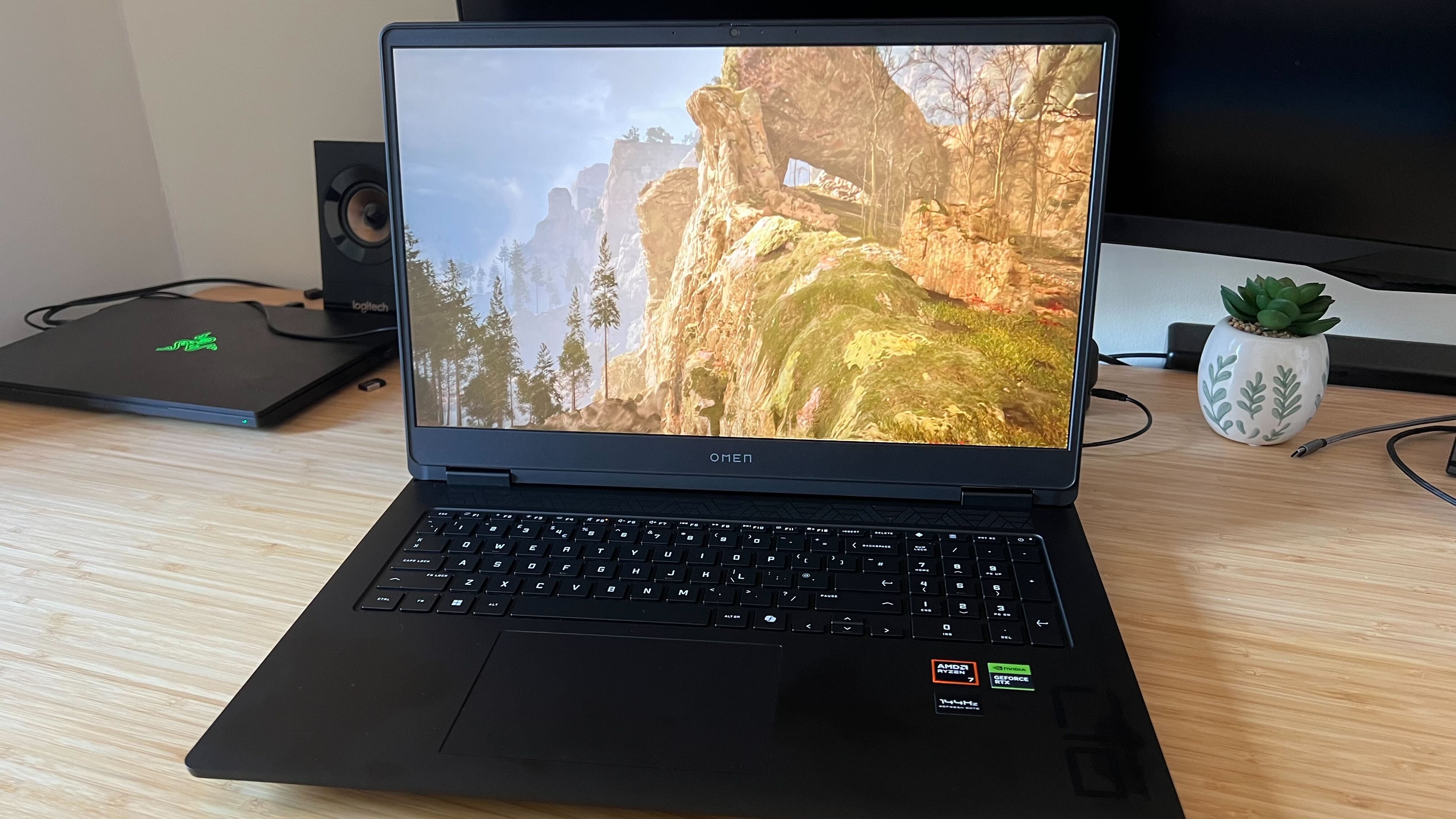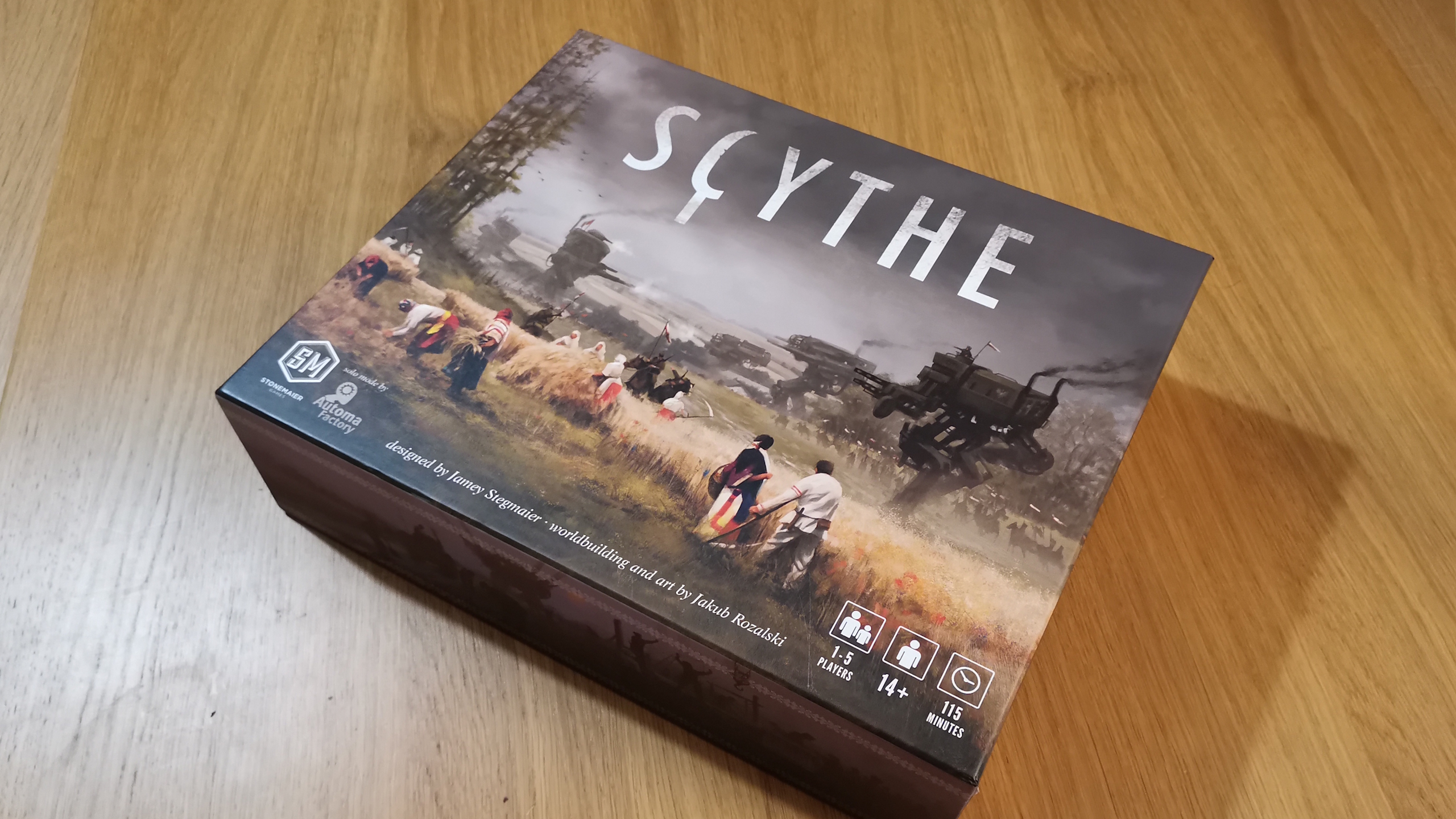GamesRadar+ Verdict
The HP Omen 17 doesn’t come in with too much of a song and dance, but that boring chassis does get the job done. With excellent RTX 4070 performance, this is a machine that knows what it’s doing internally - it’s just a shame that external features can’t quite keep up.
Pros
- +
Excellent mid-range performance
- +
Subtle design will appeal to some
- +
Wide range of configurations available
- +
Colorful display
- +
Impressive battery life
Cons
- -
Boring design
- -
Cheaper build materials
- -
Poor quality keyboard
- -
Screen lacks brightness
- -
Only one USB-C
Why you can trust GamesRadar+
October 21, 2025 - This review has been updated with details of new RTX 50-Series HP Omen models that could offer far better value overall, such as the HP Omen Max 16. The HP Omen 17 is still available, with RTX 40-Series components, and my recommendation and rating remain the same. All new information has been separated from original text, so this review remains as originally published below.
I say it every time I review an HP Omen gaming laptop, but this range will always have a special place in my heart. My very first rig was an RTX 1050 HP Omen 15, in all its chunky metallic form. The 2024 HP Omen 17 could not be further from those days. Yes, it’s still a hefty device, but gone are the red accents, textured lids, and angular decals - this is a slab of black plastic prioritizing performance over flashy external sing-song. Marrying an 8000-Series AMD processor with an Nvidia RTX 4070 GPU, it’s just on the cusp of mid-range, offering big-screen play without the hefty price tag of most 18-inch devices. The best gaming laptops pair form with functionality, and the HP Omen 17 falls short of the competition in one of these areas.
Price | $2,019.99 / £1,399.99 | $1,349.99 - $2,329.99 / £1,099.99 - £1,799.99 |
Display | 17.3-inch 1080p 144Hz | QHD, 240Hz |
Processor | AMD Ryzen 7 8845HS | AMD Ryzen 5 8645HS | AMD Ryzen 9 8945HS |
GPU | Nvidia GeForce RTX 4070 | Nvidia GeForce RTX 4050 | Nvidia GeForce RTX 4060 |
RAM | 16GB DDR5 5600MHz RAM | 32GB RAM DDR5 5600MHz RAM |
Storage | 1TB PCle Gen4 NVMe M.2 SSD | 512GB PCle Gen4 NVMe M.2 SSD |
Connectivity | WiFi 6, Bluetooth 5.3 | - |
Ports | 2x USB Type-A 10Gbps, 1x USB Type-A 5Gbps, 1x HDMI 2.1, 1x 3.5mm, 1x RJ-45, 1x USB Type-C 10Gbps (Power Delivery, DisplayPort 1.4) | - |
Dimensions | 1.18 x 15.65 x 10.94 inch | - |
Weight | 6.5lbs (2.88kg) | - |
Design
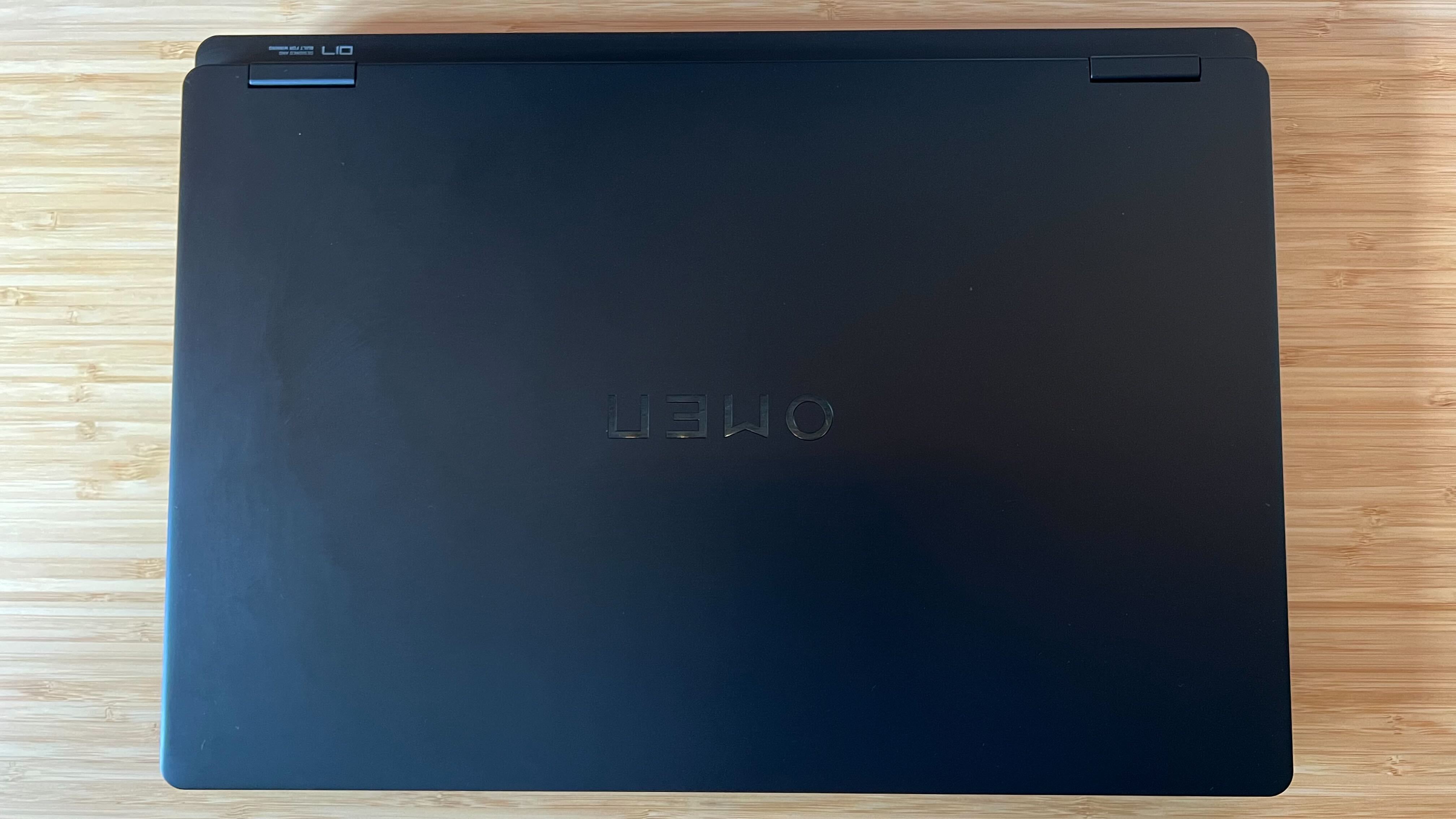
The HP Omen 17 is understated as it is, a matte black chassis with very little branding. That’s perfect for those looking to double up their gaming machine as an everyday work laptop - and something I generally praise in gaming laptop design. Very few of us want to go back to the old days of monstrously large devices extending their footprint with heavy angular detailing and constant strobing light effects. I say I normally praise an understated design in a gaming laptop because that praise is handed out when the option to add a little flair to the equation also exists. There’s no such option here.
The 2025 HP Omen Max 16 keeps a similar form factor, with a restrained design that steers clear from loud branding and cringey stamps. The new white colorway does help the recent machine stand out a little more, providing a clean experience while the HP Omen 17 runs the risk of feeling a little boring by comparison.
RGB lighting is all but non-existent on the HP Omen 17, save for a single-zone keyboard array that doesn’t even run any effects. There’s usually at least a wry nod to a laptop’s gaming roots through a lit logo or intricate grill design, but the Omen is almost pedestrian in its aesthetics. That’s certainly not helped by the all-plastic construction.
Considering you can easily spend over $2,000 on a mid-range configuration, this cheaper material is disappointing. While it’s certainly sturdy, picking up the machine from any angle still feels safe with no creaks or bends, it looks and feels far lower in budget than it should. If it weren’t for the ‘Omen’ logo embossed on the top, I could easily mistake this machine for the ageing laptop my mother bought in 2012 that begs for death every time it’s turned on. Yes, the Razer Blade 16 is minimal, but it backs that aesthetic up with an incredibly high-quality construction.
All this is to say, this is a very basic design in both aesthetic and build materials. The quality of that assembly is still reliable, though. While there’s a little flex to the main lid and internal palm rest area, it was only noticeable when directly searching for it. The fully attached hinge also operates nice and smoothly, with just a little wobble to the main display when opened. I could easily open the whole clamshell with one hand without the base tipping over.
The newer HP Omen Max 16 also suffers from this slight flexing in the main deck area.
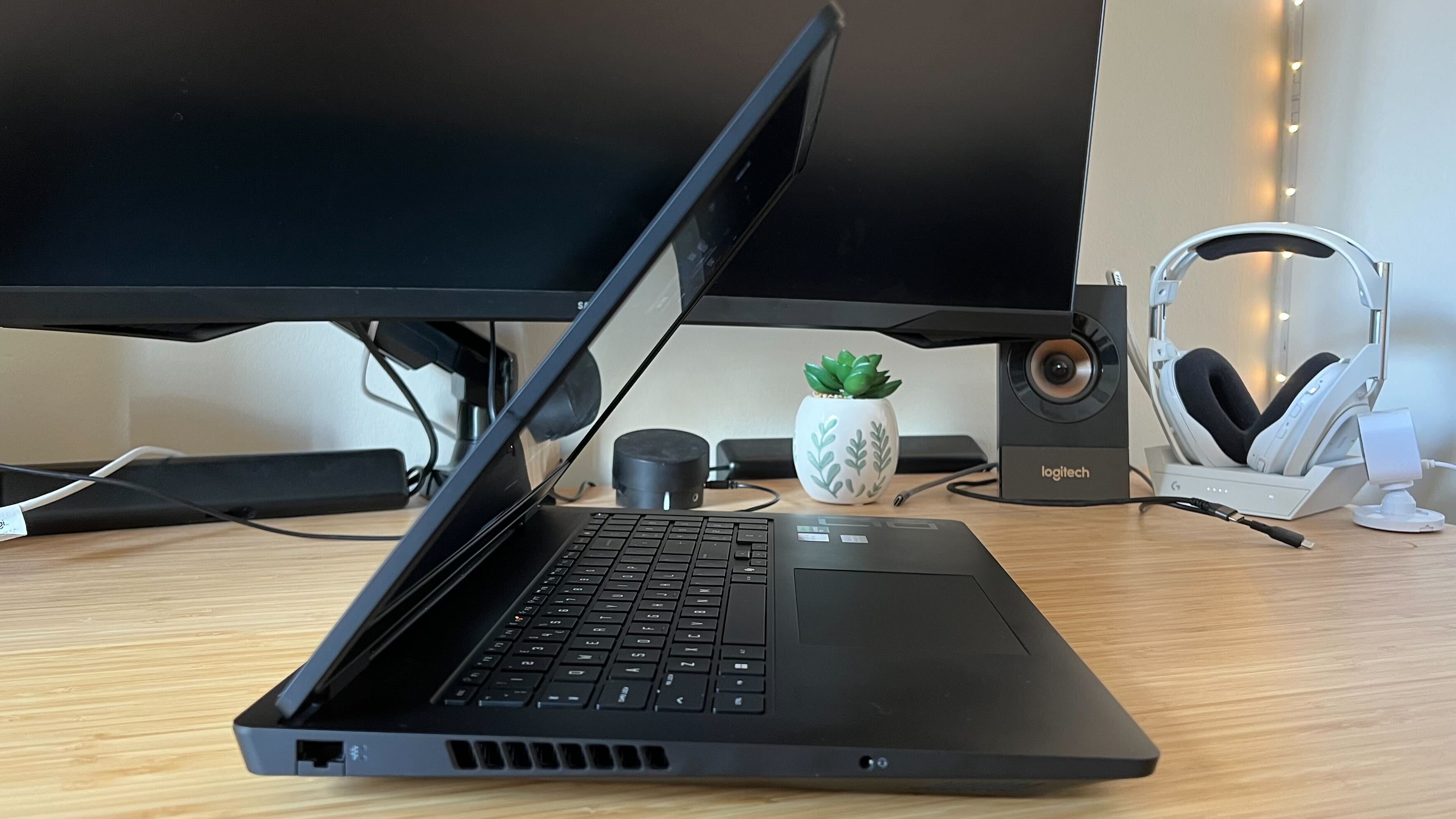
That’s because the heft of this device works in its favor in terms of durability. While the 2.88kg form factor might limit your travels with the 17-inch device and that 1.18-inch thickness is certainly taller than the Alienware M16 R2 (0.93-inch) and Acer Nitro 16 (0.98-inch), the Omen doesn’t feel like a brick on the desk. The heavily tapered front lip and all-black design go a long way to keep the Omen 17’s presence low-key, especially when compared to the blocky-feeling Asus ROG Strix Scar 18. Like most big-screen gaming laptops this isn’t a device designed for portability, but if you are keeping it close to your desk it’s not going to take over either. Plus, as we’ll see later, that extra size works particularly hard for you once you actually fire up a game.
Features
There are a number of HP Omen configurations floating around at the moment, but they all pair AMD’s 8000-series CPUs with Nvidia’s entry-level and mid-range graphics cards. At the top end of the scale, you can pack an AMD Ryzen 9 8945HS and RTX 4070 into this chassis, with 32GB DDR5 5,600MHz RAM, a 1TB SSD, and a QHD 240Hz display. That’s a fantastic set of specs for a dutifully reliable mid-range device looking to play the latest and greatest games. Having seen the results from a weaker configuration, though, I’m curious as to the potential performance we would have seen from a high-end GPU in this situation. Those after an RTX 4080 or RTX 4090 powerhouse will need to look elsewhere.
Weekly digests, tales from the communities you love, and more
Not only does the HP Omen Max 16 benefit from newer RTX 50-Series components, but its spec list extends past the HP Omen 17 as well. The rig is available with GPUs running all the way up to an RTX 5090 as well as new generation Intel and AMD processors.
My testing spec offers up a more middle of the road set of parts; an AMD Ryzen 7 8845HS, Nvidia RTX 4070, 16GB DDR5 RAM, 1TB SSD, and FHD 144Hz display. That’s still going to cost you over $2,000 at full price, though there are regular discounts on these kinds of machines.
That screen is the weakest link in the chain here, though. We’re certainly looking at some sacrifices in this panel - it’s not quite as dark as the HP Victus I’m currently testing alongside the Omen, but it’s nowhere near as bright as the Acer Nitro 16. I never struggled to play in well-lit environments, and the matte finish kept glare at bay, but there are far more powerful screens out there at this (and even lower) price point.
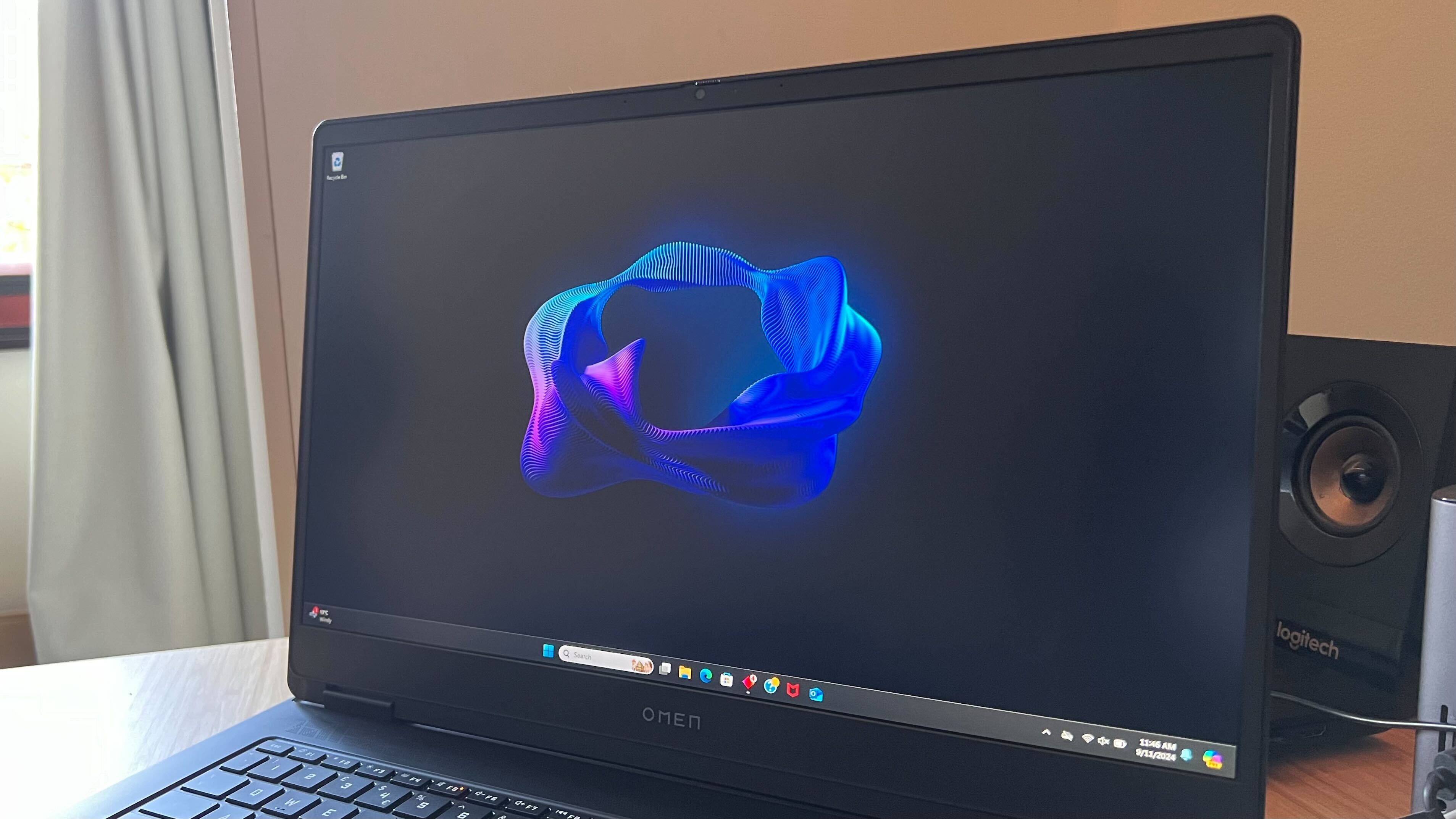
I was impressed with the colors on offer across this panel, though. Greens popped with a particularly abundant vibrancy, while the more delicate handling of reflections and more complex forest scenes holding up particularly well. You’re not quite getting the more sophisticated OLED technology of the Razer Blade 16 or the HDR capabilities of certain Asus gaming laptops, but considering you’re spending far less here than you would on either of those devices it’s an impressive experience overall.
The 2025 Omen Max 16 ramps things up with an OLED display option and it's a real upgrade in color contrast and vibrancy, while still running at QHD+ 240Hz settings. This screen doesn't quite pack the same punch as its contemporaries but is a step up from the HP Omen 17.
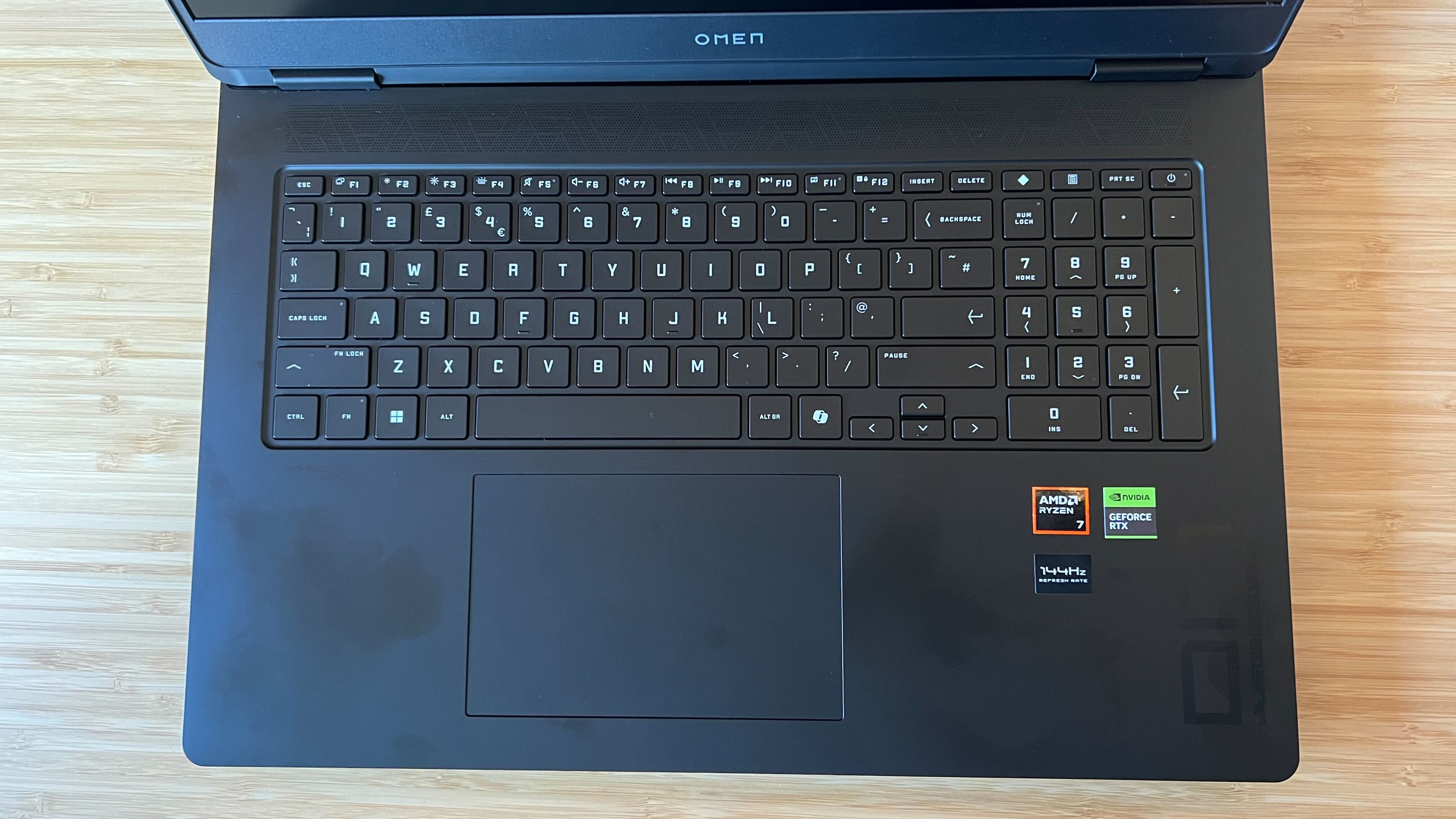
The keyboard is another story. With very low key travel, an echoey feel, and a slightly sloppy debounce, this is not a deck worthy of a gaming laptop at over $2,000 MSRP. I’m not saying a keyboard has to reach the super snappy heights of the mechanical switches featured in many Alienware laptops, but the majority of machines I’ve tested have offered far more tactility under the fingertips. There’s energy here, mostly due to the lower travel, but a too-soft landing borders on spongey. Combine that with the aforementioned lack of per-key RGB and the HP Omen 17 is lacking in its control panel. The trackpad is still more than serviceable, and remains nicely responsive with a large base.
HP has improved its keyboard for the new Max model. I found a far more satisfying feel under the fingertips in the more recent release, and while that softer feel is certainly present there's more bounce overall. You're also getting a particularly strong light show here, with pudding caps to match.
Most of the Omen’s ports are located to the rear of the machine - a win for anyone looking to keep their setup free of cable webs - but there are a few sacrifices here as well. There’s only one USB-C option on the whole device, which feels a little outdated. The majority of 2024 gaming laptops are shipping with at least two USB-C options and while you’re still getting DisplayPort 1.4 and power delivery through this connection, there’s not a Thunderbolt in sight. The lack of USB-C options and Thunderbolt might be a worthy sacrifice on a $1,500 machine, but at over $2,000 it’s difficult to rally behind. You’ll still find three USB-A ports (two on the rear and one of the right panel), as well as an Ethernet RJ45, HDMI 2.1, and 3.5mm audio.
The HP Omen max 16 adds Thunderbolt 4 into the mix this generation, though swaps one of the three USB-As on the HP Omen 17 for this newer port. You're getting two of each on the new model, while still keeping your ethernet connection. Thankfully, ports are still located on the rear.
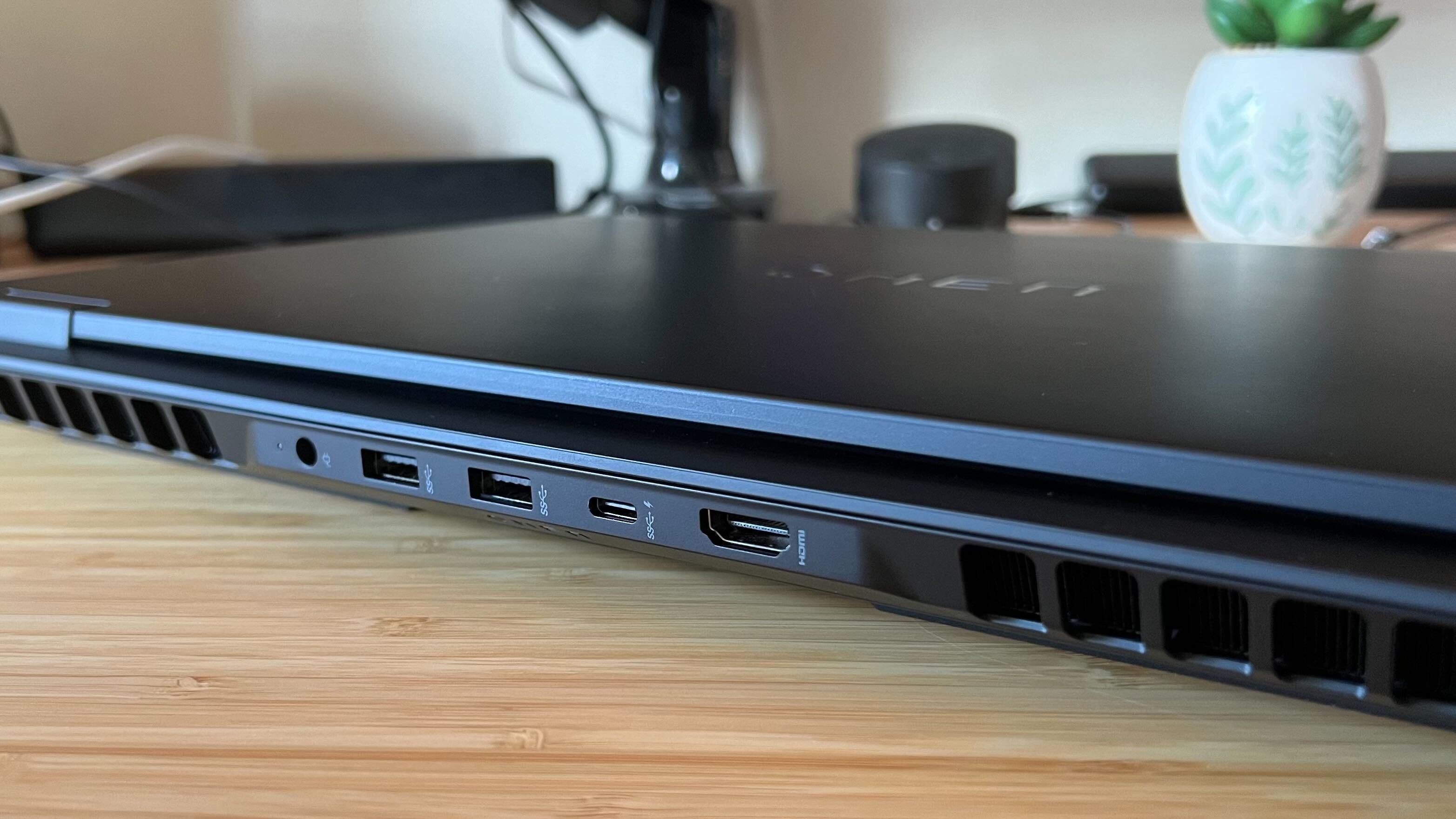
Strangely for a machine that’s looking more geared towards staying at home, the HP Omen 17 does pack a pretty impressive battery life. HP rates it at five hours on a single charge - fantastic for a gaming-specific rig. I managed to swing around two to three hours of gaming on balanced power presets, something I could never dream to achieve on other machines. How much you’ll really put that battery to the test considering the size and weight of the Omen is another matter.
Stick with the HP Omen 17 if you want to run on battery power. The newer model struggles to keep up with its components without a tether and only lasts for around an hour in-game.
Performance
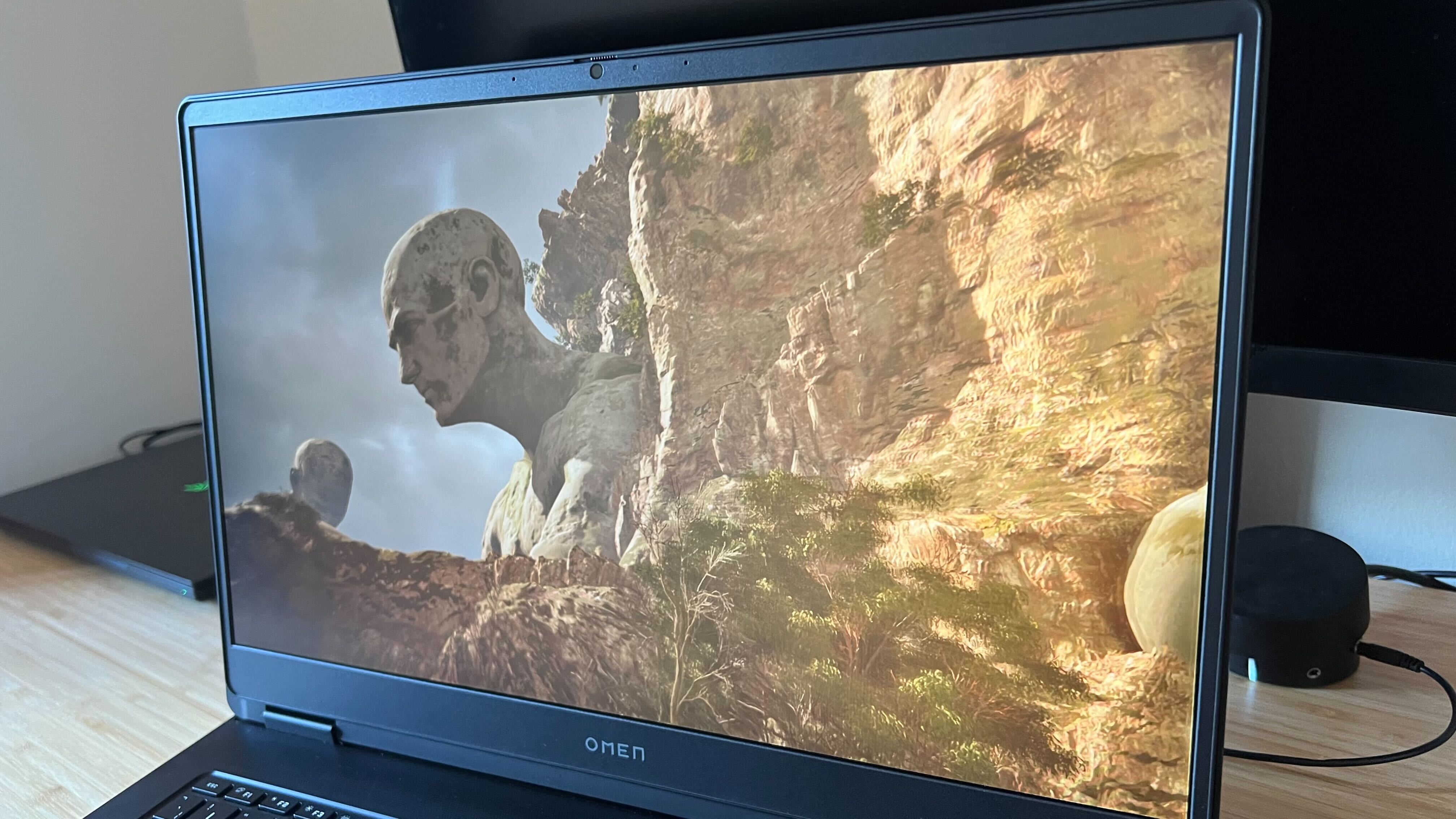
The HP Omen just nudges itself near the top of the pack in my testing comparison pool. While it can’t quite take on the Alienware M16 R2 across in-game benchmarks, it out-performs the Acer Nitro 16 with the same GPU in everything but Returnal. It’s the second highest performing RTX 4070 gaming laptop I’ve tested yet, scoring over 60fps in every test I threw at it. That’s a solid backbone to work with, proving the competitive edge to that larger chassis and additional cooling space. 1080p performance can sail you through more demanding titles and take on more Nvidia-friendly games with room to spare.
Things get even more interesting when we take synthetic benchmarks into account. The Omen 17 led the pack across both Fire Strike and Time Spy in my testing, posting scores that edged a lead over the Alienware M16 R2 and more than proved themselves against the Acer Nitro 16. These are both tests of GPU, CPU, and RAM combined performance, and such high scores within the comparison pool suggest the components selected by HP for this particular rig are playing particularly nicely with each other. With fans and operating modes set to max performance there was no evidence of throttling from either the CPU or GPU, and temperatures remained nice and cool during stress tests as well.
That AMD 8000-Series GPU means business. The Ryzen 7 8845HS employed by the Omen 17 tops my comparison pool, largely featuring previous generation Ryzen offerings and Intel processors from the last two years. The Asus ROG Zephyrus G14 bumps things up to a Ryzen 9 and still comes up short against the Omen’s PC Mark 10 score - once again demonstrating the performance boost you’ll find in a larger chassis device.
The Omen 17 excels in its CPU output and its thermal management (though those fans can grow loud once you crank up the dial). Its real-world gaming performance remains at the top of the middle, beating cheaper models comfortably in most games but struggling to get the same lift-off you’ll find in an RTX 4080 rig.
I tested an RTX 5080 configuration of the HP Omen Max 16, so direct comparisons between the RTX 4070 HP Omen 17 aren't going to be an exact science. However, the fact that the RTX 4070 represents the best performance you'll get out the older machine it's worth noting that you get far higher headroom options out of the Max. The RTX 5080 configuration sees improvements of 32% in Fire Strike and 65% Time Spy benchmark scores. It's going to cost you more, but it's an option now.
Should you buy the HP Omen 17?
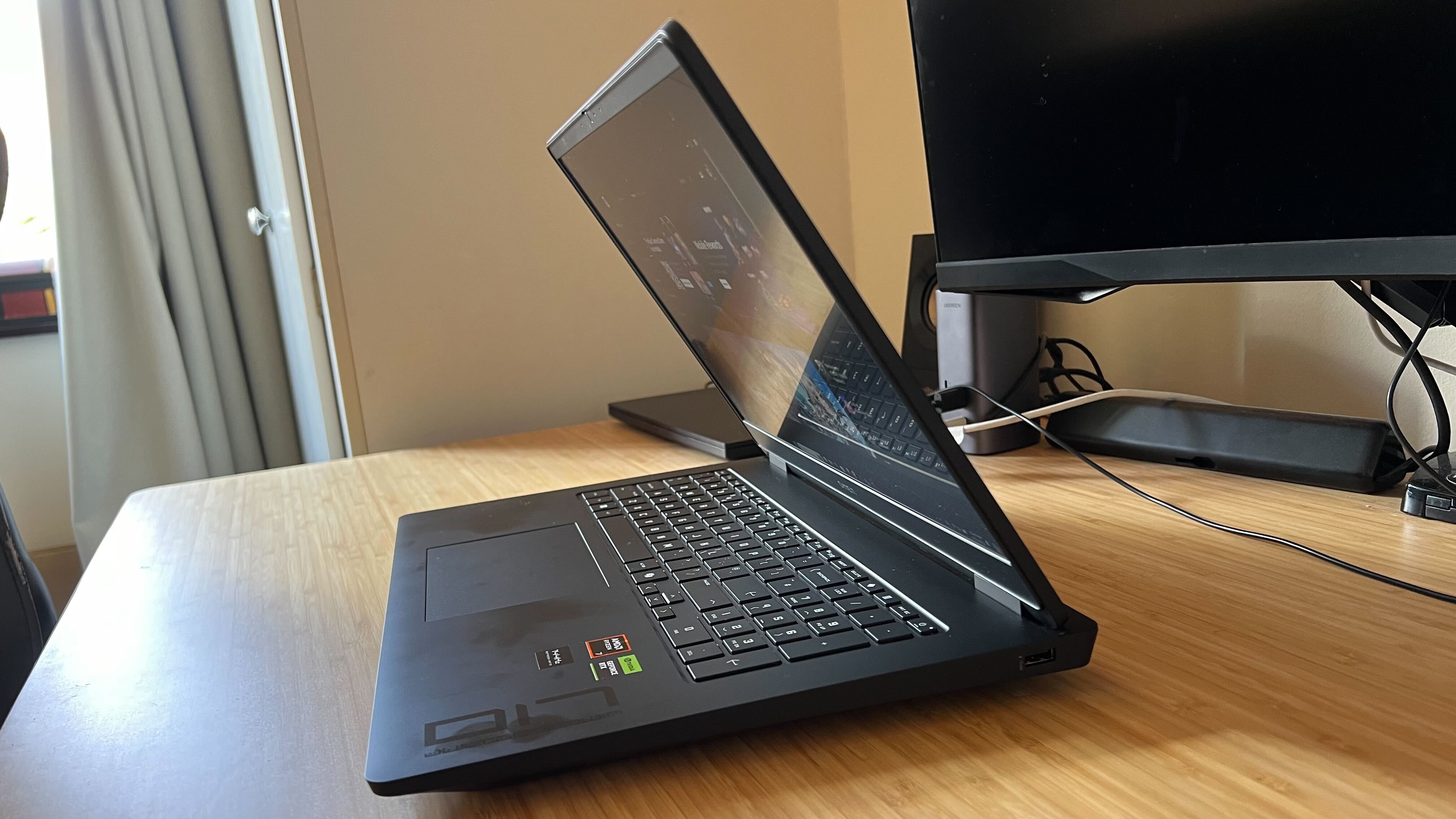
The HP Omen 17 prides itself on its performance, bleeding its RTX 4070 dry and putting a fantastic Ryzen CPU in centre stage. If you’re looking for a solid mid-range performer that won’t take over your desk with RGB lights then this is absolutely the machine for you. While ports are a little limited, you’ve still got that DisplayPort 1.4 USB-C to connect to a range of external monitors - and that also gives you the chance to hook up your own gaming keyboard if you want a more tactile experience while at home. Ultimately, I’d recommend the Omen 17 to anyone who wants to keep their laptop closed when connected to a full gaming setup but still needs the option to play in different locations when required.
If you’re after an everyday machine that can double up as a gaming rig, I’d look elsewhere. The Asus ROG Zephyrus G16 or G14 are far better suited to the work / play hybrid lifestyle at around the same price for an RTX 4070 configuration. They make marked improvements to your display, form factor, and overall portability, though you are making some minor sacrifices to performance.
If you’re wondering whether the 17.3-inch HP Omen can be used as a full desktop replacement, I’d think again. The screen just isn’t high quality enough to take on other 18-inch rigs at similar prices, and the keyboard experience falls far short of the rest of the market. I’d look to an Alienware M18 for a better value desktop replacement experience. Prices can jump here as you scale the GPU ladder, but you’re still getting plenty of power at a fair rate.
How I tested the HP Omen 17
I used the HP Omen 17 for all daily work and play for a period of one week, with another week spent testing the device alongside the Lenovo Legion Pro 7i Gen 9. During this time, I primarily played The Outer Worlds, Fallout 4, and Assassin’s Creed: Odyssey, while also stress testing in-game benchmarks across Shadow of the Tomb Raider, Total War: Three Kingdoms, Returnal, and The Talos Principle 2. I carried out synthetic benchmarks in 3D Mark’s Time Spy, Fire Strike, and Steel Nomad tests as well as Geekbench 6, and explored CPU performance using PC Mark 10 and Cinebench R24. For more information on how we test gaming laptops, check out the full GamesRadar+ Hardware Policy.
We’re also rounding up all the best Razer laptops on the market as well as the best gaming PCs for those looking for a more permanent setup.

Managing Editor of Hardware at GamesRadar+, I originally landed in hardware at our sister site TechRadar before moving over to GamesRadar. In between, I've written for Tom’s Guide, Wireframe, The Indie Game Website and That Video Game Blog, covering everything from the PS5 launch to the Apple Pencil. Now, i'm focused on Nintendo Switch, gaming laptops (and the keyboards, headsets and mice that come with them), PS5, and trying to find the perfect projector.
You must confirm your public display name before commenting
Please logout and then login again, you will then be prompted to enter your display name.
